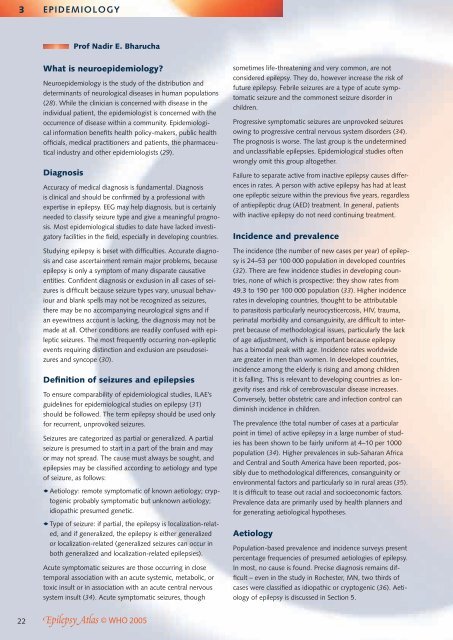Epilepsy - World Health Organization
Epilepsy - World Health Organization
Epilepsy - World Health Organization
Create successful ePaper yourself
Turn your PDF publications into a flip-book with our unique Google optimized e-Paper software.
3 EPIDEMIOLOGY<br />
22<br />
Prof Nadir E. Bharucha<br />
What is neuroepidemiology?<br />
Neuroepidemiology is the study of the distribution and<br />
determinants of neurological diseases in human populations<br />
(28). While the clinician is concerned with disease in the<br />
individual patient, the epidemiologist is concerned with the<br />
occurrence of disease within a community. Epidemiological<br />
information benefits health policy-makers, public health<br />
officials, medical practitioners and patients, the pharmaceutical<br />
industry and other epidemiologists (29).<br />
Diagnosis<br />
Accuracy of medical diagnosis is fundamental. Diagnosis<br />
is clinical and should be confirmed by a professional with<br />
expertise in epilepsy. EEG may help diagnosis, but is certainly<br />
needed to classify seizure type and give a meaningful prognosis.<br />
Most epidemiological studies to date have lacked investigatory<br />
facilities in the field, especially in developing countries.<br />
Studying epilepsy is beset with difficulties. Accurate diagnosis<br />
and case ascertainment remain major problems, because<br />
epilepsy is only a symptom of many disparate causative<br />
entities. Confident diagnosis or exclusion in all cases of seizures<br />
is difficult because seizure types vary, unusual behaviour<br />
and blank spells may not be recognized as seizures,<br />
there may be no accompanying neurological signs and if<br />
an eyewitness account is lacking, the diagnosis may not be<br />
made at all. Other conditions are readily confused with epileptic<br />
seizures. The most frequently occurring non-epileptic<br />
events requiring distinction and exclusion are pseudoseizures<br />
and syncope (30).<br />
Definition of seizures and epilepsies<br />
To ensure comparability of epidemiological studies, ILAE’s<br />
guidelines for epidemiological studies on epilepsy (31)<br />
should be followed. The term epilepsy should be used only<br />
for recurrent, unprovoked seizures.<br />
Seizures are categorized as partial or generalized. A partial<br />
seizure is presumed to start in a part of the brain and may<br />
or may not spread. The cause must always be sought, and<br />
epilepsies may be classified according to aetiology and type<br />
of seizure, as follows:<br />
◆ Aetiology: remote symptomatic of known aetiology; cryptogenic<br />
probably symptomatic but unknown aetiology;<br />
idiopathic presumed genetic.<br />
◆ Type of seizure: if partial, the epilepsy is localization-related,<br />
and if generalized, the epilepsy is either generalized<br />
or localization-related (generalized seizures can occur in<br />
both generalized and localization-related epilepsies).<br />
Acute symptomatic seizures are those occurring in close<br />
temporal association with an acute systemic, metabolic, or<br />
toxic insult or in association with an acute central nervous<br />
system insult (34). Acute symptomatic seizures, though<br />
sometimes life-threatening and very common, are not<br />
considered epilepsy. They do, however increase the risk of<br />
future epilepsy. Febrile seizures are a type of acute symptomatic<br />
seizure and the commonest seizure disorder in<br />
children.<br />
Progressive symptomatic seizures are unprovoked seizures<br />
owing to progressive central nervous system disorders (34).<br />
The prognosis is worse. The last group is the undetermined<br />
and unclassifiable epilepsies. Epidemiological studies often<br />
wrongly omit this group altogether.<br />
Failure to separate active from inactive epilepsy causes differences<br />
in rates. A person with active epilepsy has had at least<br />
one epileptic seizure within the previous five years, regardless<br />
of antiepileptic drug (AED) treatment. In general, patients<br />
with inactive epilepsy do not need continuing treatment.<br />
Incidence and prevalence<br />
The incidence (the number of new cases per year) of epilepsy<br />
is 24–53 per 100 000 population in developed countries<br />
(32). There are few incidence studies in developing countries,<br />
none of which is prospective: they show rates from<br />
49.3 to 190 per 100 000 population (33). Higher incidence<br />
rates in developing countries, thought to be attributable<br />
to parasitosis particularly neurocysticercosis, HIV, trauma,<br />
perinatal morbidity and consanguinity, are difficult to interpret<br />
because of methodological issues, particularly the lack<br />
of age adjustment, which is important because epilepsy<br />
has a bimodal peak with age. Incidence rates worldwide<br />
are greater in men than women. In developed countries,<br />
incidence among the elderly is rising and among children<br />
it is falling. This is relevant to developing countries as longevity<br />
rises and risk of cerebrovascular disease increases.<br />
Conversely, better obstetric care and infection control can<br />
diminish incidence in children.<br />
The prevalence (the total number of cases at a particular<br />
point in time) of active epilepsy in a large number of studies<br />
has been shown to be fairly uniform at 4–10 per 1000<br />
population (34). Higher prevalences in sub-Saharan Africa<br />
and Central and South America have been reported, possibly<br />
due to methodological differences, consanguinity or<br />
environmental factors and particularly so in rural areas (35).<br />
It is difficult to tease out racial and socioeconomic factors.<br />
Prevalence data are primarily used by health planners and<br />
for generating aetiological hypotheses.<br />
Aetiology<br />
Population-based prevalence and incidence surveys present<br />
percentage frequencies of presumed aetiologies of epilepsy.<br />
In most, no cause is found. Precise diagnosis remains difficult<br />
– even in the study in Rochester, MN, two thirds of<br />
cases were classified as idiopathic or cryptogenic (36). Aetiology<br />
of epilepsy is discussed in Section 5.

















